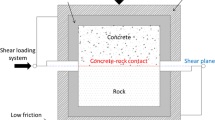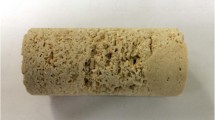Abstract
The samples of slightly weathered granite drilled before the construction of Runyang suspended bridge's north anchorage are used as the research object in this paper. Through a lot of shear strength tests of concrete-bedrock rough cement face, the influence of the cement face roughness on the shear strength, shear deformation characteristics and shear failure mechanism were systematically studied. The results show that: The post-peak stress–strain curves of smooth and rough cement faces are obviously different. The shear stress–strain curve of cement face can be generalized into 3 types. The shear stress–strain model of rough cement face is the most general form, and the smooth cement face and no cementation are its special cases. The empirical relation between cement face roughness JRC and shear strength parameters is established by the fitting of experimental data. When the cement face is climbing, the internal friction angle increases with the climbing angle. When the climbing angle is constant, the increase of cohesion is positively correlated with the ratio of fluctuation difference and wavelength. When the climbing thrust is equal to the gnawing thrust, the specimen is transformed from climbing to gnawing.











Similar content being viewed by others
References
Barton N (1973) Review of a new shear-strength criterion for rock joints. Eng Geol 7:287–332
Barton N (1976) The shear strength of rock joints in theory and practice. Int J Rock Mech Mining Sci Geomech Abstr 13:255–279
Deere DU, Miller RP (1966) Engineering classification and index properties for intact rocks. Technical report, Air Force Weapons Laboratory, New Mexico 65–116
Fardin N, Stephansson O, **g L (2001) The scale dependence of rock joint surface roughness. Int J Rock Mech Min Sci 38:659–669
Johansson F, Stille H (2014) A conceptual model for the peak shear strength of fresh and unweathered rock joints. Int J Rock Mech Min Sci 69:31–38
Kumar R, Verma AK (2016) Anisotropic shear behavior of rock joint replicas. Int J Rock Mech Min Sci 90:62–73
Li Y, Oh J, Mitra R, Hebblewhite B (2016) A constitutive model for a laboratory rock joint with multi-scale asperity degradation. Comput Geotech 72:143–151
Li Y, Zhang Y (2015) Quantitative estimation of joint roughness coefficient using statistical parameters. Int J Rock Mech Min Sci 77:27–35
Liu Q, Tian Y, Liu D, Jiang Y (2017a) Updates to JRC-JCS model for estimating the peak shear strength of rock joints based on quantified surface description. Eng Geol 228:282–300
Liu XG, Zhu WC, Yu QL et al (2017b) Estimation of the joint roughness coefficient of rock joints by consideration of two-order asperity and its application in double-joint shear tests. Eng Geol 220:243–255
Patton FD (1966) Multiple modes of shear failure in rock. 1st Congress of international society of rock mechanics
Singh HK, Basu A (2018) Evaluation of existing criteria in estimating shear strength of natural rock discontinuities. Eng Geol 232:171–181
Sun GZ (1979) Discussion on climbing angle. Hydrogeol Eng Geol 6:1–3 (in Chinese)
Tian Y, Liu Q, Ma H, Liu Q, Deng P (2018) New peak shear strength model for cement filled rock joints. Eng Geol 233:269–280
Yang L, Xu W, Meng Q et al (2017) Investigation on jointed rock strength based on fractal theory. J Cent South Univ 24:1619–1626
**e HP (1995) Fractal description of rock joints. Chinese J Geotech Eng 17:18–23 (in Chinese)
Acknowledgements
This research was funded by the National Natural Science Foundation of China (Grant Number 41831278, 51579081 and 51709184) and the Central Public-Interest Scientific Institution Basal Research Fund (Grant Number Y118008).
Author information
Authors and Affiliations
Corresponding author
Ethics declarations
Conflict of interest
The authors declare that there is no conflictof interests regarding the publication of this paper.
Additional information
Publisher's Note
Springer Nature remains neutral with regard to jurisdictional claims in published maps and institutional affiliations.
Rights and permissions
About this article
Cite this article
**, Y., Sun, B., Zhu, Z. et al. Study on Shear Strength of Cement Face Between Rock and Concrete. Geotech Geol Eng 39, 3829–3841 (2021). https://doi.org/10.1007/s10706-021-01730-1
Received:
Accepted:
Published:
Issue Date:
DOI: https://doi.org/10.1007/s10706-021-01730-1




